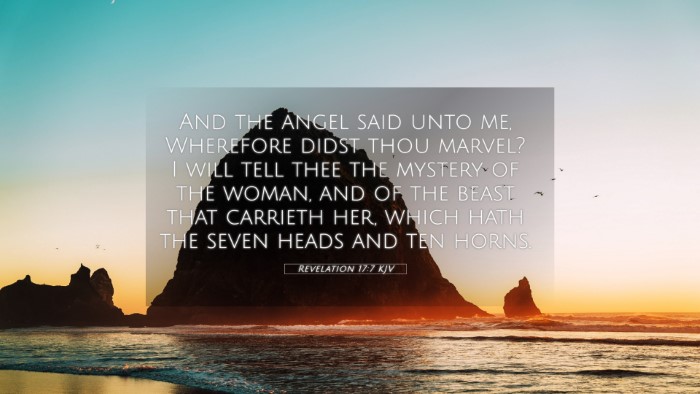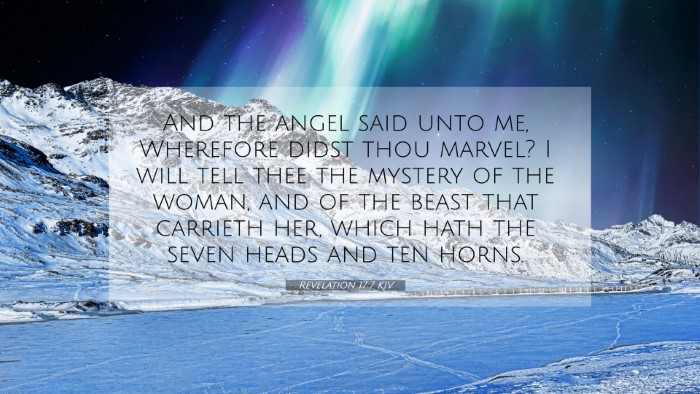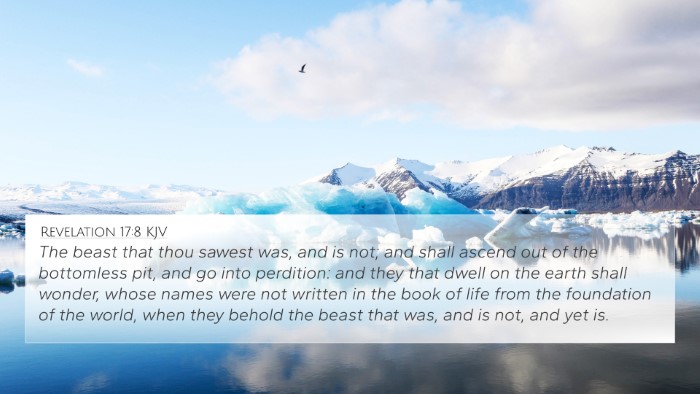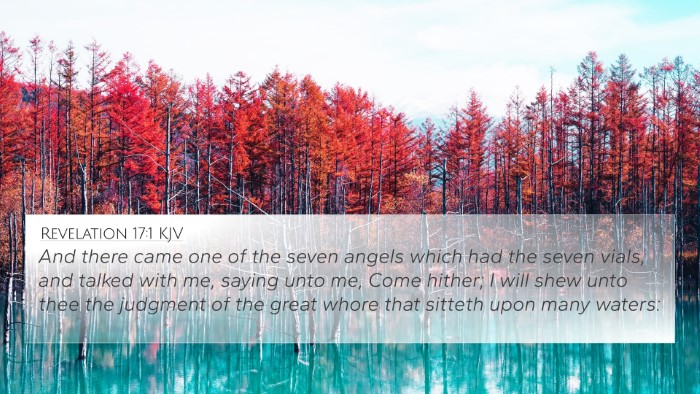Understanding Revelation 17:7
Revelation 17:7 states: "And the angel said unto me, Wherefore didst thou marvel? I will tell thee the mystery of the woman, and of the beast that carrieth her, which hath the seven heads and ten horns." This verse serves as a crucial bridge to comprehend the broader themes of Revelation. Here we delve into a detailed analysis, pulling insights from renowned public domain commentaries.
Verse Context and Interpretation
The context of Revelation 17 revolves around the imagery of a symbolic woman, often interpreted as representing a corrupt entity or system, riding on a beast. The angel’s inquiry highlights John’s marveling at the intricate symbols presented to him.
Matthew Henry notes that the beast embodies both political power and spiritual deception, while Adam Clarke emphasizes that the seven heads and ten horns hold significant meaning relating to various kingdoms and their leaders throughout history.
Key Themes
- The Nature of the Beast: Represents a composite of governmental oppression and spiritual corruption.
- The Woman's Identity: Seen in many interpretations as representing false religious systems.
- Mystery and Revelation: The unveiling of hidden truths through divine revelation, as emphasized by Albert Barnes.
Bible Cross-References
To fully appreciate the nuances within Revelation 17:7, it can be helpful to explore related Bible verses that offer deeper insights. Here are notable cross-references:
- Daniel 7:7-8: Discusses the fourth beast with ten horns, echoing imagery found in Revelation.
- Revelation 13:1: Describes a beast rising from the sea with seven heads and ten horns.
- Revelation 17:3: Portrays John seeing the woman upon the beast, providing contextual background.
- Isaiah 47:8-9: Symbolically parallels the judgment of Babylon, similar themes are reflected in Revelation's symbolism.
- Revelation 18:7: Expands on the fall of the great harlot, a crucial connection to the themes of mystery and corruption.
- 2 Thessalonians 2:3-4: Discusses the man of sin, drawing connections with the overarching themes of rebellion against God.
- Zechariah 5:5-11: Illustrates the vision of a woman in a basket, signifying wickedness, which complements the Revelation imagery.
Connections and Interpretation Techniques
Understanding Revelation 17:7 benefits from comparative analysis with both Old and New Testament texts. Methods such as thematic Bible verse connections can illuminate the meaning behind the symbolism.
Inter-Biblical dialogue emerges through linking various scriptures, allowing for a comprehensive understanding of concepts like divine judgment and the nature of false prophets.
Cross-Referencing Approaches
Utilizing tools for Bible cross-referencing is vital in deepening one’s study. A Bible concordance can assist in finding connections, while systematic cross-reference guides provide structured means for exploration.
For those interested in detailed study, drawing parallels between Gospels or identifying links between the Prophets and the Apostolic teachings can serve as a robust methodology for scriptural understanding.
Conclusion
Revelation 17:7 invites a profound exploration of biblical themes. Its rich imagery benefits from intertextual analysis, employing various cross-referencing strategies opens avenues for deeper comprehension of God’s messages through the Scriptures.




